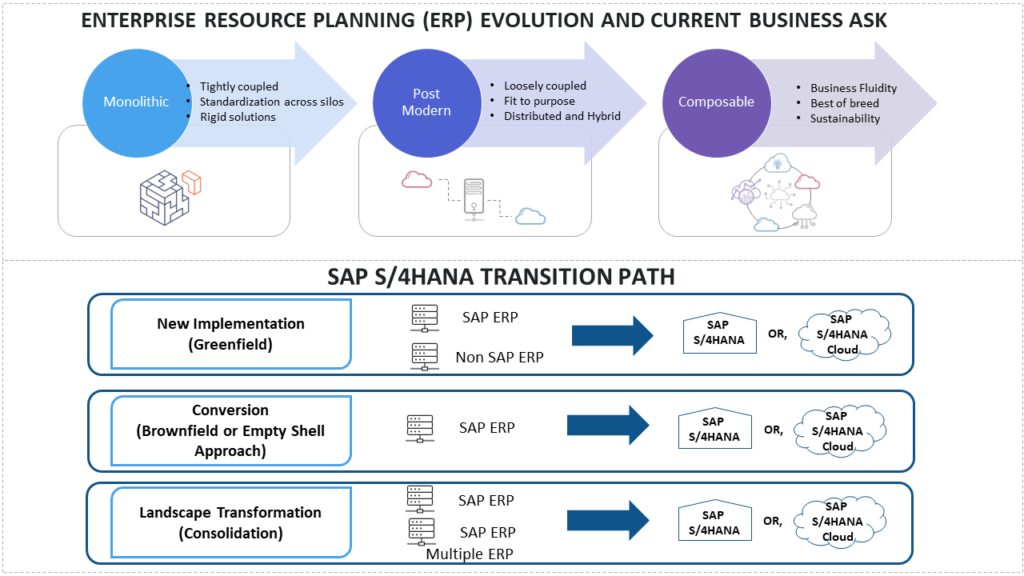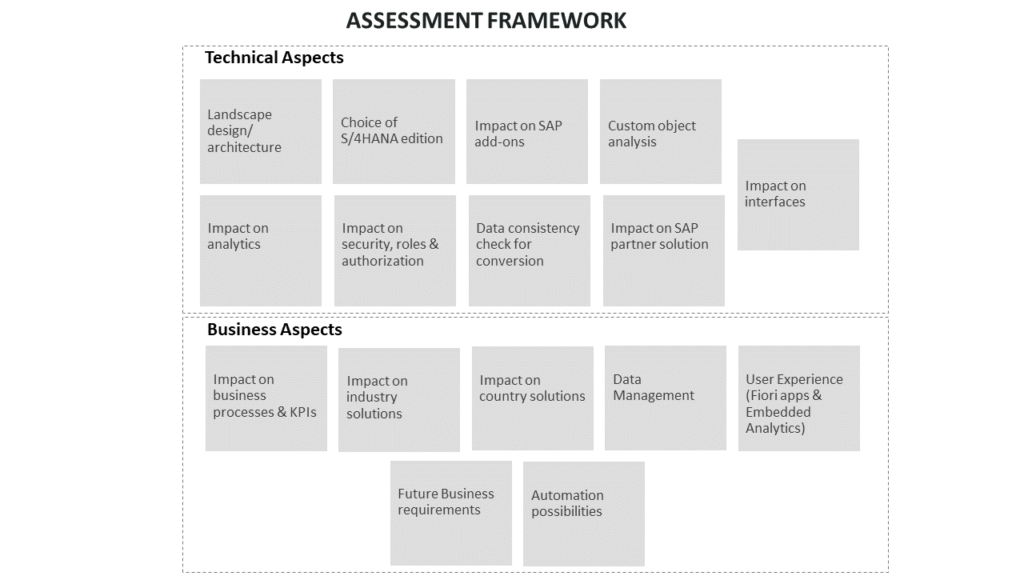Assessment Framework Enables Optimal SAP S/4HANA Migration
Why Assessments Are Necessary for S/4HANA Migration
Meet the Authors
To respond to the rapidly changing business environment, enterprises need to adopt new ERP technologies, such as SAP S/4HANA. However, every enterprise has its own individual rationale for upgrading the technology stack such as end of infrastructure life, process harmonization, merger and acquisitions, or future proofing products and services.
SAP S/4HANA is the next-generation ERP, which ensures best in class technologies deliver best in class business outcomes. While SAP S/4HANA can help the enterprise move towards the desired digital transformation, there are multiple options on choosing the best fit migration path. Multiple alternatives exist for upgrading from the legacy SAP ECC to SAP S/4HANA, and this brings up the first problem statement on whether to choose greenfield implementation or conversion/migration. It is for resolving this problem that an assessment framework is needed. This is highlighted in Figure 1.

Explore related questions
Figure 1: Transformation Evolution and SAP S/4HANA Transition Path
The Right Assessment for the Right Migration
There are typically three possible alternatives available for transformation to SAP S/4HANA. This article focuses on the first two alternatives of greenfield (new implementation) or conversion from SAP ECC to SAP S/4HANA. There is a third alternative of SAP landscape transformation that is relevant for enterprises having multiple disparate SAP ERPs and wanting to consolidate them to a single SAP S/4HANA system or use selective data migration.
First Alternative: Greenfield – New Implementation to SAP S/4HANA
A greenfield approach is when an enterprise on SAP ECC or non-SAP ERP moves to SAP S/4HANA through a fresh implementation. The enterprise needs to evaluate all the process afresh and adopt current best practices where the process is not unique to the enterprise. Adoption can be done using the on-premises or cloud solution while data can be loaded using data migration tools.
Second Alternative: Conversion – SAP ECC to SAP S/4HANA
For enterprises currently on SAP ECC, migration to SAP S/4HANA can be achieved through:
Brownfield:
In the brownfield process, conversion happens for all elements, such as configuration, custom development, master, and transactional data, at the same time.
Bluefield:
In the empty shell or bluefield approach, only configuration and custom development are converted. One can adopt additional functionality prior to master and transaction data migration.
Assessing the current scope and future requirement will help identify the appropriate alternatives along with possible roadmap and timeline. It helps in identifying the business value and build the business case for stakeholder buy-in.
Assessment Framework
For an enterprise embarking on the assessment path for SAP S/4HANA implementation, there are a few keys areas that need attention from a business as well as a technical perspective. There is a need to ensure that business-related aspects address the impact on business process and KPIs, current solution, industry solution, country solution, data management, user experience, automation, and future business capabilities. Additionally, the assessment should address technical-related aspects such as impact on landscape design and architecture, choice of SAP S/4HANA edition, add-ons, interfaces, custom objects, analytics, security, and authorization.
Assessment to identify and evaluate business and technical aspects needs inputs for various tools and reports. This is highlighted in Figure 2.

Figure 2: Assessment Framework’s Key Elements
Assessment Tools
There are multiple tools that enable the assessment evaluation defined in the previous sections. Below is a list of key tools provided by SAP to enable quick and relevant assessment.
S/4HANA Readiness Check 2.0: This tool enables the enterprise to identify whether the current SAP ECC system would be compatible for conversion to SAP S/4HANA. It highlights aspects such as relevant simplification items, Fiori apps recommendations, business process discovery, Idoc and BW extractor integration compatibility, custom code impact, etc.
Process Discovery for SAP S/4HANA Transformation: This tool supports building a business case for SAP S/4HANA and ensuring stakeholder buy-in by providing insights into an as-is operational business process performance, functional usage, and industry benchmarks for selected six lines of business, seven end-to-end processes, 12 business optimization goals with metrics, and automation possibilities.
SAP Fiori Apps Recommendation Report: This report provides a high-level as-is analysis of the operational SAP ECC, analyzing key transactions while mapping against SAP Fiori apps in order to gain the best fit options for productivity improvement (end-user and workflow) and change management.
SAP Value Life Cycle Manager (VLM): This tool assists customers in creating a guided business case and benchmark the process maturity as a part of their journey to SAP S/4 HANA. The SAP-provided benchmarks defined in the VLM are gathered across 8,000 organizations and 2,500 KPIs grouped by over 35,000 best practices. This enables an enterprise to compare strategic KPIs with best-in-industry or cross-industry benchmarks. Finally, the VLM provides guidance for the business case cost-benefit data based on ROI, NPV, Payback period, etc.
Transformation Navigator: This is a self-service tool, which delivers the future product map based on current usage and customer preferences. The tool gauges the current IT landscape, business direction, and industry movements and delivers an exhaustive report. Easily downloadable, it contains enterprise-specific approaches of the SAP solution and products relevant for digital transformation.
SAP Roadmap Explorer: This tool provides a comprehensive list of innovations to be launched by quarter. New SAP S/4HANA features to be launched can be accessed based on products, processes, and industries.
SAP Innovation and Optimization Pathfinder: This tool provides SAP innovations based on business KPIs. It is available for ECC 6.0 and S/4HANA. Business and IT recommendations are delivered across a single report. The report covers six lines of business from a functional perspective.
SAP Best Practices Explorer: This is the next-generation web channel to search, browse, and consume SAP and partner best practices. The Explorer enables users to find the appropriate best practices and rapid deployment solutions. In-depth guides are also available, which can be used to set up best practice content including predefined master data and configuration settings. This tool also contains process flow diagrams and test scripts.
SAP Quick Sizer: SAP quick sizer tool can be leveraged to size HANA database and S/4H application layer. It is relevant for enterprises interested in implementing greenfield projects.
SAP Sizing Report: This tool is generated for enterprises already using SAP ECC systems and wanting to migrate to SAP S/4HANA. It is more relevant for conversion projects, i.e., brownfield/empty shell/bluefield projects.
Based on the enterprise requirement, the relevant reports need to be used. These reports provide information and insight to make informed decisions about the right migration approach. In building an assessment framework, it becomes essential to pick the best reports, which can deliver maximum value to the business by upgrading to SAP S/4HANA.
Assessment Framework Benefits
The key benefits to developing an assessment framework as a foundation stone to S/4HANA upgrade are:
Risk Mitigation:
Preempt risks by assessing possible roadblocks to the transition to SAP S/4HANA. Plan ahead to address specific challenges both from a technology as well as a business perspective
Maximize Value:
Deliver a seamless transition experience with multiple facets of migration to SAP S/4HANA. Assessments enable you to foresee probable challenges and select the best fit approach to achieving transformation goals.
Lower Total Cost of Ownership:
With maximum risks accounted for, there are minimal unforeseen challenges. This enables the transition to be delivered well within budget.
End-User Delight:
Since assessments take into account not only the technical aspects but also business best practices, change management will be in line with business expectations. This ensures end-user delight with minimal change requests.
Conclusion
Multiple alternatives exist to migrate from SAP ECC to SAP S/4HANA, such as greenfield, conversion, or landscape transformation. To address the decision about options, there is a need to engage an experienced organization that can complete the assessment and provide a roadmap and recommendations using relevant tools and reports. As every enterprise is different, unique propositions need to be developed based on the company’s objectives and economics. These can also help build a draft roadmap and business case to take to enterprise management/board for project approval. The roadmap and business case can be used to engage service integrators for guidance in the RFI and RFP process. An assessment is essential to understand the needs of the enterprise on the road to digital transformation.








